Verano |
|||||||||||||||||||
|
|
|||||||||||||||||||
Crochet DROPS jacket with lace pattern and double treble crochet in ”Cotton Merino”. Size: S - XXXL.
DROPS 153-14 |
|||||||||||||||||||
|
CROCHET INFO: Replace first dtr at beg of every dtr row with 4 ch. PATTERN: See diagrams A.1 - A.5. CROCHET TIP: ROW 1 in diagram A.4 and A.5 are not worked on back piece but on front piece. BUTTONHOLES: Do not dec for buttonholes but sew the buttons on to left band and button between two dtr/triple tr in right band. Sew on buttons measured from cast-on edge as follows: SIZE S/M: 12, 20, 28, 36 and 44 cm SIZE L/XL: 14, 22, 30, 38 and 46 cm SIZE XXL: 10, 20, 30, 40 and 50 cm SIZE XXXL: 12, 22, 32, 42 and 52 cm ---------------------------------------------------------- BACK PIECE: Worked back and forth. Work 83-95-108-120 ch on hook size 5 mm with Cotton Merino. Work first row as follows (= WS): 1 dc in 2nd ch from hook = 1 dc, 1 dc in each of the next 1-3-1-3 ch, * skip 1 ch, 1 dc in each of the next 4 ch *, repeat from *-* 16-18-21-23 times = 66-76-86-96 dc. Continue to work as follows: ROW 1 (= RS): Work A.1 1 time, then work A.2 until 8 dc remain (= 10-12-14-16 times in width) and finish with A.3 1 time. REMEMBER THE CROCHET TENSION! ROW 2 (= WS): Turn piece and work A.3 1 time, A.2 (= 10-12-14-16 times in width), A.1 1 time. ROW 3 (= RS): Turn piece and work A.1 1 time, A.2 (= 10-12-14-16 times in width), A.3 1 time. Repeat 2nd and 3rd row until piece measures approx. 29-28-28-29 cm - adjust to finish with 3rd row (= RS). Fasten off. Continue to work as follows: * Work 10-5-5-5 loose ch, beg from WS and continue A.3, A.2 and A.1 over back piece as before and finish with 10-5-5-5 loose ch, turn piece. Continue to work as follows: ROW 1 (= RS): Work 5 ch, in 10th ch from hook work 2 dtr + 2 ch + 2 dtr (= 1 repetition of A.1), work A.2 2-1-1-1 time (work last repetition of A.2 around the 2 ch in A.1 from previous row). Then continue with A.2 10-12-14-16 times in total over the entire back piece as before and finish row as follows: Work A.2 around the 2 ch in A.3 from previous row, then continue with A.2 1-0-0-0 times, and then A.3 the last 1 dtr will be in 1st ch on previous row. Cut the yarn and turn piece *, in size L/XL – XXL – XXXL repeat *-* 1 more time, AT THE SAME TIME work 2 extra repetitions of A.2 over back piece. I.e. work 1 extra repetition of A.2 over the inc repetition from previous row in each side of piece = 16-18-20 repetitions in total of A.2 in size L/XL – XXL – XXXL. Do not repeat *-* in size S/M but continue as explained below: Work 13-13-13-13 loose ch, beg from WS and continue with A.2 in ch-space from A.3 on previous row, A.2 over sleeves and back piece as before, and A.2 in ch-space in A.1 on previous row and finish with 13-13-13-13 loose ch. Continue to work as follows: ROW 1 (= RS): Work A.1 and A.2 1 time over the new sts. Continue with A.2 over sleeves and back piece as before and finish with 1 repetition of A.2 and A.3. Continue this pattern until piece measures approx. 49-51-55-57 cm - adjust to finish after a row from WS. Then finish each shoulder separately as follows: RIGHT SHOULDER: Work A.1 1 time and A.2 5-6-6-7 times in total, then work 2nd row of diagram A.4 – READ CROCHET TIP! Turn and work 3rd row of A.4, and continue row with A.2 and A.1 as before. Continue like this until piece measures 52-54-58-60 cm in total. Fasten off. LEFT SHOULDER: Work left shoulder the same way but reversed, and work A.3 instead of A.1 and 2nd row of A.5 instead of A.4. Beg with 2nd row of A.5 in the middle of row, so that there are 4-4-6-6 repetitions of A.2 in width for neck. RIGHT FRONT PIECE: Worked back and forth. Work 45-52-58-64 ch on hook size 5 mm with Cotton Merino. Work first row as follows (= WS): 1 dc in 2nd ch from hook, 1 dc in each of the next 4-1-2-3 ch, * skip 1 ch, 1 dc in each of the next 4 ch *, repeat from *-* 7-9-10-11 times in total and finish with 1 dc in each of the next 4 ch = 37-42-47-52 dc. ROW 1 (= RS): 4 ch (= 1 dtr), 1 dtr in each of the next 3 dc (= 4 dtr for band) NOTE: Work band with every other row dtr and triple tr. Then work A.2 5-6-7-8 times in total, finish with A.3 1 time. Repeat this pattern, with 4 dtr/triple tr for band towards mid front until piece measures approx. 29-28-28-29 cm – adjust according to back piece and finish with a row from RS. Fasten off. Then work 10-5-5-5 loose ch for sleeve and continue as on back piece. When piece measures 42-44-46-48 cm, work as follows on 1st row from WS: Pattern as before until 3 repetitions of A.2 and 4 dtr remain. Work pattern according to diagram A.5 over these sts. Turn and work A.5, continue row with pattern as before. Continue like this back and forth until piece measures 52-54-58-60 cm in total. Fasten off. LEFT FRONT PIECE: Work as right but reversed. Work according to diagram A.1 instead of A.3, and when neck dec beg, work according to A.4 instead of A.5. ASSEMBLY: Place front piece on top of back piece and work the shoulders as follows: * 1 dc through both layers, 3 ch, skip 2 dtr *, repeat from *-*. Work the sides tog as follows: 1 dc, * 3 ch, 1 dc in ch-space on next row *, repeat from *-*. Work tog under sleeves as follows: * 1 dc in ch in next dtr-group, 3 ch *, repeat from *-* and finish with 1 dc. Sew buttons on left band and button through two dtr/triple tr in right band. NECK EDGE: Work a neck edge as follows, beg from WS: ROW 1: Fasten yarn with 1 dc at the edge, * 3 ch, skip approx. 2 cm, 1 dc *, repeat from *-* around the entire neck edge. Turn piece. ROW 2: 4 ch, 3 dtr in first ch-space, * 3 dtr in next ch-space *, repeat from *-* along the entire row, and finish with 1 dtr in first ch on previous row. Turn piece. ROW 3: * 3 ch, skip 3 dtr, 1 dc between the next two dtr-groups *, repeat from *-* along the entire row. Turn piece. ROW 4: 2 ch, 1 dc in first ch-space, * 2 ch, 1 dc in next ch-space *, repeat from *-* along the entire row. Fasten off. |
|||||||||||||||||||
Diagram explanations |
|||||||||||||||||||
|
|||||||||||||||||||

|
|||||||||||||||||||
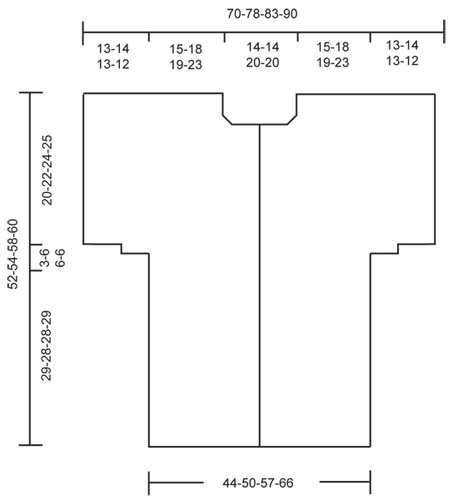
|
|||||||||||||||||||
|
Have you made this or any other of our designs? Tag your pictures in social media with #dropsdesign so we can see them! Do you need help with this pattern?You'll find tutorial videos, a Comments/Questions area and more by visiting the pattern on garnstudio.com. © 1982-2024 DROPS Design A/S. We reserve all rights. This document, including all its sub-sections, has copyrights. Read more about what you can do with our patterns at the bottom of each pattern on our site. |
|||||||||||||||||||








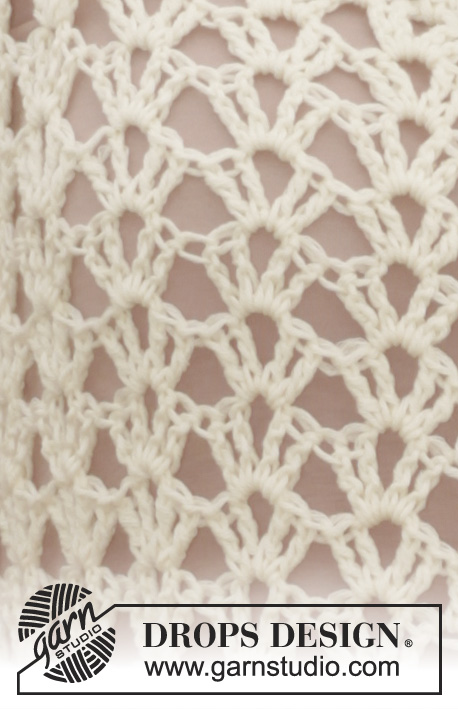











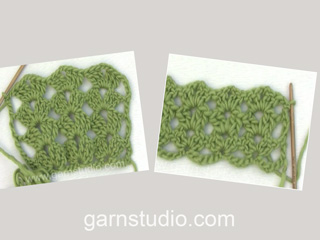
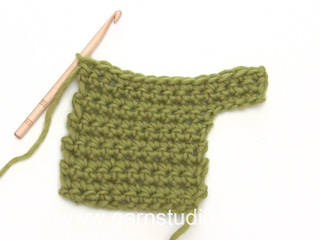














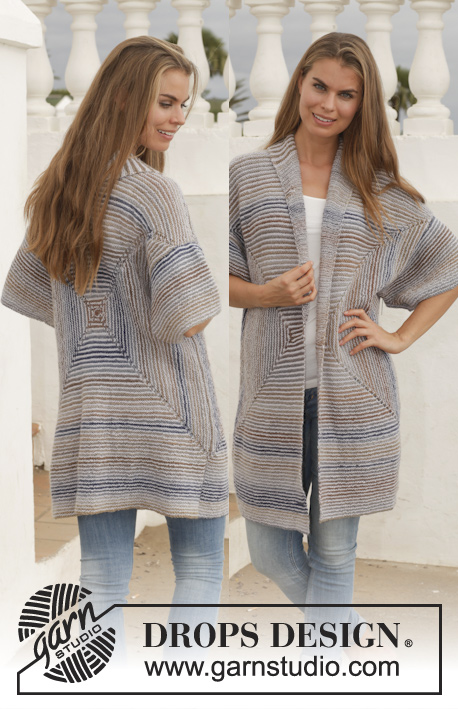








Comments / Questions (108)
Guten Tag, ich würde gerne dieses Oberteil häkeln verstehe aber folgenden Anleitungsschritt zu Beginn des Rückenteils nicht: "1 fM in jede der nächsten 1-3-1-3 Lm". Bedeutet dies, eine fM in die nächste Lm, dann 2 Lm auslassen und eine fM in die 3. Lm? Beste Grüsse
09.05.2023 - 04:26DROPS Design answered:
Liebe Frau Braun, da die Luftmaschenkette am Anfang ist oft eng wird man hier mehr Luftmaschen häkeln als man fMaschen braucht, und bei der 1. Reihe werden dann regelmäßig verteilt Luftmaschen übersprungen. Viel Spaß beim häkeln!
09.05.2023 - 07:50Geweldig vestje maar heb al aardig wat zitten studeren op het achterpand.. bij de meerderend voor de mouw kan ik het niet meer volgen. Een foto zou zo behulpzaam zijn. Is het mogelijk om ergens een foto te plaatsen van het gebreide achterpand? Want dan kan ik misschien zien of ik het nu wel of niet goed heb gedaan.. ik hoor het graag, bedankt alvast!
24.04.2023 - 19:36DROPS Design answered:
Dag Ina,
Helaas is er geen foto van het achterpand. Als je begint met de armsgaten dan heb je eerst het werk afgehecht en begin je met een nieuwe draad om lossen mee te haken. Wanneer je deze 10-5-5-5 (10 voor maat S/M, 5 voor de andere maten) hebt gehaakt, dan haak je verder over het zojuist afgehechte achterpand terwijl je gehaakte lossen nog aan je haaknaald bungelen. Aan het eind van de toer haak je weer 10-5-5-5 lossen. Op deze manier heb je aan beide kanten gemeerderd voor de mouwen. In een van de video's onderaan het patroon wordt dit ook uitgelegd.
24.04.2023 - 20:50Hej Jeg vil gerne have lange ærmer i jakken. Kan man lave det? Og i så fald hvordan?
08.01.2023 - 18:27DROPS Design answered:
Hej Lena, du hækler bare flere lm når du kommer til ærmerne, du har 13 dbl-st eller 3 rapporter A.2 på 10 cm i bredden :)
10.01.2023 - 13:42Achterpand heb ik zonder problemen gehaakt. Nu ik met het voorpand ben begonnen kom ik niet uit. Ik haak maat XXL. 1. Volgens mij moet ik start met 65 lossen ipv 64 om tot 52 steken te komen. Ik sla de volgende steken over 1, 6, 11,16,21,36,41,46,51,56,61. Dit zijn totaal 13. 64-13 is 51 ipv 52. 2. Vervolgens haak ik 4xdstk. 8x A2. in de steken 9,14,19,24,29,34,39,44. En 1xA3 in steek 49. Er blijven dan 3 steken over ipv 5 voor de laatst dstk. Wat moet ik doen?
28.12.2021 - 17:56DROPS Design answered:
Dag Gerda,
Voor het opzetten zou je een paar extra lossen op kunnen zetten. De overgebleven lossen kun je later uithalen. Het gaat erom dat je 47 vasten hebt voor maat xxl voordat je begint aan toer 1. Op toer 1 haak je vervolgens 4 driedubbele stokjes (het eerste driedubbele stokje wordt vervangen door 4 lossen), dan 7 keer A.2 = 35 steken en éen keer A.3 = 8 steken is in totaal 47 steken voor maat xxl.
29.12.2021 - 12:49Good afternoon! I am a beginner en really enjoying the pattern. Where is the pattern for the sleeves?
22.05.2021 - 17:22DROPS Design answered:
Dear Magie, there are no separate sleeves, but stitches are added on, and then cast off to/from the body. Happy Crafting!
23.05.2021 - 02:21Het is een moeilijk patroon, d.w.z. de beschrijving is gebrekkig. Ik heb het onderste gedeelte van het achterpand gehaakt en moet nu meerderen maar met deze omschrijving kom ik er niet uit. Je moet 5 lossen haken en dan? Moet je die dan aan het andere haakwerk vastmaken en wat betekent de uitdrukking na de haak? Is dat na de haaknaald? Graag een duidelijke tekening erbij van het meerderen. En wat moet ik doen als ik de mouwen langer wil hebben, moet ik dan meer dan 13 lossen haken?
27.09.2020 - 19:40DROPS Design answered:
Dag Adri,
Als het goed is ben je aan het einde van een toer aan de goede kant, voordat je begint met het opzetten van steken voor de mouwen. Je haakt dan eerst 5 lossen en haakt dan terug over de verkeerde kant, het betekent dus dat er een herhaling van A.2 bij is gekomen met de 5 extra lossen. Aan het eind van de toer haak je weer 5 lossen extra. Op deze manier maak je een mouw. Voor de grotere maten moet je wat tussen de sterretjes staat nog een keer herhalen. Als je de mouw langer wilt maken, zul je meer steken aan het eind op moeten zetten in een meervoud van 5 steken.
20.11.2020 - 11:52Ik vindt al uw te maken projecten zeer mooi! Al merk ik dat er bij elk patroon zoveel verwarring is bij de breisters/haaksters ! Volgens mij moet de beschrijving van de patronen eenvoudiger worden opgesteld want op geen enkel andere handwerk site worden er zoveel moeilijkheden gevonden.
01.09.2020 - 16:47Bonjour, \"ajuster pour arrêter après 1 rang à l envers\". Quel est le repère ? Le fil de la chaînette se trouve à gauche ou à droite de l ouvrage quand on termine ce rang ? J espère me faire comprendre .....Merci d avance.
16.04.2020 - 19:02DROPS Design answered:
Bonjour Fanny, utilisez le 1e rang du dos comme repère, le tout 1er rang se fait sur l'envers, puis le 1er rang des diagrammes (= A.1, A.2) se fait sur l'endroit. Bon crochet!
17.04.2020 - 09:35Hi, I’ve started A1 and did the first row of tr, but how do I go back to the beginning to start the second row? Do I turn my work around?
13.08.2019 - 05:46DROPS Design answered:
Dear Susy, you first work from RS: A.1 one time in width, then repeat A.2 in width until 8 sts remain, and now work A.3. Then turn and work from WS: A.3, repeat A.2 and finish row with A.1. Read more about crochet diagrams here. Happy crocheting!
13.08.2019 - 08:31Ist es korrekt, dass der Halsausschnitt am Rückenteil nicht so breit ist wie auf der Vorderseite? Bei den Schultern der Rückseite habe ich 6 Rapporte A.2, beim Vorderteil nur 4. Ich kann den Fehler nicht entdecken, gehe aber davon aus, dass die Schultern gleich breit sein sollen.
27.06.2019 - 21:21DROPS Design answered:
Liebe Kitty, die Schultern sollen gleich sein, dh wenn Sie 6 Rapporte A.2 beim Rückenteil haben, sollen Sie auch 6 Rapporte A.2 beim jeden Vorderteil haben. Viel Spaß beim häkeln!
28.06.2019 - 06:30